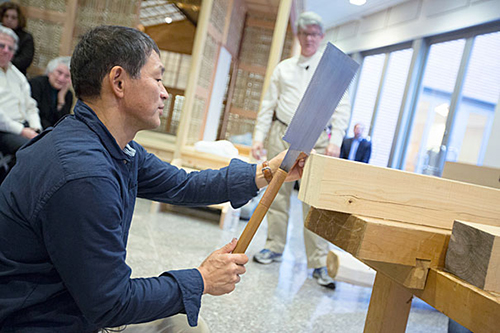Harvard Gazette: ‘The Thinking Hand’
By Corydon Ireland, Harvard Gazette

Photo: Kris Snibbe/Harvard Staff Photographer
Akinori Abo, a master carpenter from Japan, picked up a thin-bladed crosscut saw and drew it quickly through a 6-inch block of wood. Each time he pulled the rattan-wrapped handle back, the blade hissed and aromatic sawdust streamed to the floor. Abo’s final cut drew a burst of wild applause.
It may seem odd to applaud a man for sawing wood, or demonstrating a carpenter’s square, or drawing a heavy plane across a wide board. But consider that Abo’s shavings were three times thinner than a human hair, curling up from the plane like a paper scroll. Or that the block of wood afterward was as smooth as ivory. The applause, from 50 onlookers at Harvard’s Center for Government and International Studies (CGIS), was an acknowledgement of awe for Abo’s craftsmanship.
His intimacy with his tools — each plane tuned like a piano, each saw blade lovingly sharpened — showed a mind in concert with muscles, a harmonious lineage of style that dates back more than 1,300 years.
The demonstration by Abo, who has been a master carpenter for 40 years, launched “The Thinking Hand,” an exhibit of the tools, traditions, techniques, and woods of traditional Japanese carpentry. (The exhibit is open through March 25 at the Japan Friends of Harvard Concourse in the CGIS Building at 1730 Cambridge St.)
Included are displays of tools used for primary shaping, fine shaping, and joinery. There is a display of the four woods most common in Japanese traditional building, along with boxes of shavings from each, which exhibit-goers are encouraged to smell. A daiku, or master carpenter, can identify each wood by its scent alone.
In the exhibit, there are two architectural scale models of the kind long used by daiku to project the complex geometry of projects that often use irregularly shaped native wood.
The exhibit also features a full-size sukiya teahouse that Abo built in Japan and then reassembled in Cambridge. The structure, which is modest and tiny and seemingly fragile, has the usual features intended to embody serenity, simplicity, and the spirit of wood that lives on after cutting: round pillars, tatami floors, and walls of lashed members ready for a stucco of earth.
“It’s a 3-D jigsaw puzzle, very precisely joined,” said Harvard anthropologist Theodore C. Bestor of the structure, which is open for two shoeless visitors at a time. Bestor, an authority on Japan’s food and popular culture, is director of the Reischauer Institute of Japanese Studies, an exhibit co-sponsor that is celebrating its 40th anniversary this academic year. “The Thinking Hand,” he said, is the biggest anniversary event of this year.
Helping Abo saw, plane, measure, and mark during the Jan. 17 demonstration was his 28-year-old apprentice, Takumi Kato, a fifth-generation carpenter. Providing a running translation at the demonstration was Harrelson “Hap” Stanley of Pepperell, Mass., who studied carpentry during a dozen years in Japan.
Harvard’s Graduate School of Design (GSD), the other co-sponsor, plans a permanent display in Gund Hall for the traditional tools, which were donated by the Takenaka Corp. The axes, saws, chisels, gimlets, planes, hammers, and other implements of wood and hand-forged steel represent Japan’s golden age of tool-making during the Meiji period a century and more ago. By then, samurai were no longer allowed to carry swords in public, and so makers of the famous tempered blades sometimes turned to making fine tools.
Read the entire article on Harvard Gazette.
